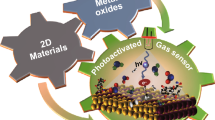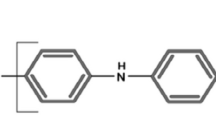Abstract
Silicon (Si); the most abundant raw material on the earth’s crust upholds a promising future in the silicon or electronic industry. However, the intrinsic indirect bandgap (1.12 eV), limits its usage in optoelectronics devices due to the passage of the infrared spectrum. Herein, we have structurally modified the Si structure into a nanostructured material like porous silicon (PS) for application in optoelectronic devices. In order to make PS structures, n-type monocrystalline Si was anodized in an ethanoic-HF solution. The average diameter of the pores created by anisotropic electrochemical etching with fixed time and current density was determined to be around 250 nm. The PS demonstrated a direct bandgap and an energy gap of 1.73 eV. The obtained PS-based device’s photoresponse was investigated at various laser irradiation wavelengths. The best response sensitivity of 11.18% was noted at a wavelength of 786 nm, thus, promising to be a potential material for visible range photodetectors.




Similar content being viewed by others
Data availability
Not applicable.
Code availability
Not applicable.
References
R. Moretta, L. De Stefano, M. Terracciano, I. Rea, Porous silicon optical devices: recent advances in biosensing applications. Sensors 21, 1336 (2021)
W.G. Kreyling, M. Semmler-Behnke, Q. Chaudhry, A complementary definition of nanomaterial. Nano Today 5, 165–168 (2010)
Y. Abdi, J. Derakhshandeh, P. Hashemi et al., Light-emitting nano-porous silicon structures fabricated using a plasma hydrogenation technique. Mater. Sci. Eng. B 124, 483–487 (2005)
A. Uhlir, Electrolytic shaping of germanium and silicon. Bell Syst. Tech. J. 35, 333–347 (1956)
V. Torres-Costa, R.J. Martín-Palma, Application of nanostructured porous silicon in the field of optics. A review. J. Mater. Sci. 45, 2823–2838 (2010)
J.-C. Lin, Y.-H. Lai, S.-H. Lu et al., Improvement of a capacitive UV-sensor by porous silicon powders embedded in epoxy on porous silicon film. Opt. Mater. Express 12, 3143 (2022)
M.S. Choi, H.G. Na, A. Mirzaei et al., Room-temperature NO2 sensor based on electrochemically etched porous silicon. J. Alloys Compd. 811, 151975 (2019)
M.P. Stewart, J.M. Buriak, Chemical and biological applications of porous silicon technology. Adv. Mater. 12, 859–869 (2000)
Y.-Y. Song, P. Schmuki, Modulated TiO2 nanotube stacks and their use in interference sensors. Electrochem. Commun. 12, 579–582 (2010)
W. Zhang, A. Farooq, W. Wang, Generating silicon nanoparticles using spark erosion by flushing high-pressure deionized water. Mater. Manuf. Process. 31, 113–118 (2016)
M.A. Siddiqui, P. Jaiswal, Photocatalytic behavior of ferroelectric materials: comparative study of BaTiO3 and Ag-loaded BaTiO3 for wastewater treatment. IOP Conf. Ser.: Mater. Sci. Eng. 1166, 012031 (2021)
Y. Zhang, J. Chen, L. Zhu, Z.L. Wang, Self-powered high-responsivity photodetectors enhanced by the pyro-phototronic effect based on a BaTiO3 /GaN Heterojunction. Nano Lett. 21, 8808–8816 (2021)
G. Madhaiyan, T.-W. Tung, H.-W. Zan et al., UV-enhanced room-temperature ultrasensitive NO gas sensor with vertical channel nano-porous organic diodes. Sens. Actuators B 320, 128392 (2020)
S. Ahmed, A. Ansari, A.S. Haidyrah et al., Hierarchical molecularly imprinted inverse Opal-Based platforms for highly selective and sensitive determination of histamine. ACS Appl. Polym. Mater. 4, 2783–2793 (2022)
M. Imran, A.A. Chaudhary, S. Ahmed et al., Iron oxide nanoparticle-based ferro-nanofluids for advanced technological applications. Molecules 27, 7931 (2022)
N. Hamdaoui, I. Ben Elkamel, A. Mezni et al., Highly efficient, low cost, and stable self-powered UV photodetector based on Co2+:ZnO/Sn diluted magnetic semiconductor nanoparticles. Ceram. Int. 45, 17729–17736 (2019)
A. Khan, S. Ahmed, B.-Y. Sun et al., Self-healable and anti-freezing ion conducting hydrogel-based artificial bioelectronic tongue sensing toward astringent and bitter tastes. Biosens. Bioelectron. 198, 113811 (2022)
L. Mandal, N.S. Chaudhari, S. Ogale, Self-powered UV-vis photodetector based on ZnIn2S4 /hydrogel interface. ACS Appl. Mater. Interfaces 5, 9141–9147 (2013)
F. Akbar, M. Kolahdouz, S. Larimian et al., Graphene synthesis, characterization and its applications in nanophotonics, nanoelectronics, and nanosensing. J. Mater. Sci.: Mater. Electron. 26, 4347–4379 (2015)
M. Kolahdouz, B. Xu, A.F. Nasiri et al., Carbon-related materials: graphene and carbon nanotubes in semiconductor applications and design. Micromachines 13, 1257 (2022)
P. Ranjan, P. Tiwary, A.K. Chakraborty et al., Graphene oxide based free-standing films for humidity and hydrogen peroxide sensing. J. Mater. Sci.: Mater. Electron. 29, 15946–15956 (2018)
A. Sinha, P. Ranjan, A.D. Thakur, Effect of characterization probes on the properties of graphene oxide and reduced graphene oxide. Appl. Phys. A 127, 1–13 (2021)
P. Ranjan, V. Thomas, P. Kumar, 2D materials as a diagnostic platform for the detection and sensing of the SARS-CoV-2 virus: a bird’s-eye view. J. Mater. Chem. B 9, 4608–4619 (2021)
A. Khan, S.M. Islam, S. Ahmed et al., Direct CVD growth of graphene on technologically important dielectric and semiconducting substrates. Adv. Sci. 5, 1800050 (2018)
A. Khan, J. Cong, R.R. Kumar et al., Chemical vapor deposition of graphene on self-limited SiC interfacial layers formed on silicon substrates for heterojunction devices. ACS Appl. Nano Mater. 5, 17544 (2022)
J. Cong, A. Khan, P. Hang et al., Graphene/Si heterostructure with an organic interfacial layer for a self-powered photodetector with a high ON/OFF ratio. ACS Appl. Electron. Mater. 4, 1715–1722 (2022)
J. Cong, A. Khan, J. Li et al., Direct growth of graphene nanowalls on silicon using plasma-enhanced atomic layer deposition for high-performance si-based infrared photodetectors. ACS Appl. Electron. Mater. 3, 5048–5058 (2021)
M. Imran, S. Ahmed, A.Z. Abdullah et al., Nanostructured material-based optical and electrochemical detection of amoxicillin antibiotic. Luminescence (2022). https://doi.org/10.1002/bio.4408
H.A. Hadi, R.A. Ismail, N.J. Almashhadani, Preparation and characteristics study of polystyrene/porous silicon photodetector prepared by electrochemical etching. J. Inorg. Organomet. Polym. 29, 1100–1110 (2019)
C.W. Jang, D.H. Shin, S.-H. Choi, High-photoresponse and broad-band graphene/WS 2 /Porous-Si heterostructure photodetectors. ACS Appl. Nano Mater. 5, 13260–13266 (2022)
I. Mal, S. Singh, D.P. Samajdar, Design and simulation of InAsBi PIN photodetector for Long wavelength Infrared applications. Mater. Today: Proc. 57, 289–294 (2022)
A. Kumar, P. Ranjan, Defects signature in VOC characterization of thin-film solar cells. Sol. Energy 220, 35–42 (2021)
S. Ahmed, S. Khatun, S. Sallam et al., Photoresponse of porous silicon for potential optical sensing. EPL 139, 36001 (2022)
C. Huo, J. Wang, H. Fu et al., Metal-assisted chemical etching of silicon in oxidizing HF solutions: origin, mechanism, development, and black silicon solar cell application. Adv. Funct. Mater. 30, 2005744 (2020)
M. Kadlečíková, J. Breza, Ľ Vančo et al., Raman spectroscopy of porous silicon substrates. Optik 174, 347–353 (2018)
M. Das, D. Sarkar, Morphological and optical properties of n-type porous silicon: effect of etching current density. Bull. Mater. Sci. 39, 1671–1676 (2016)
Acknowledgements
SA and AA are grateful to the Indian Institute of Technology Jodhpur, Rajasthan, India, for providing research facilities, infrastructure, and financial support. SA and AA would like to thank the Ministry of Human Resource Development for the financial support. The authors are thankful to Sprint Testing Solution and the Indian Institute of Technology Patna for providing a few characterization techniques facilities. PR would like to thank Science and Engineering Research Board for Start-up Research Grant (Grant nos. SRG/2022/000192, SRG/2022/000825, and SRG/2022/001377) for collaboration and Science for Equity Empowerment and Development Grant No. I/SEED/PRJ/20220044.
Author information
Authors and Affiliations
Author notes
Shahzad Ahmed and Arshiya Ansari have contributed equally to this work.
Contributions
SA: Conceptualization, investigation, writing—original draft, and figure drawings, visualization reviewing, and editing. AA: Conceptualization, investigation, writing—original draft, figure drawings, visualization reviewing, and editing. MAS: Writing—original draft, and figure drawings. AK: Supervision, conceptualization, visualization—reviewing, and editing. PR: Supervision, conceptualization, visualization—reviewing, and editing.
Corresponding authors
Ethics declarations
Conflict of interest
The authors declare that they have no conflict of interest.
Ethical approval
Not applicable.
Additional information
Publisher’s Note
Springer Nature remains neutral with regard to jurisdictional claims in published maps and institutional affiliations.
Rights and permissions
Springer Nature or its licensor (e.g. a society or other partner) holds exclusive rights to this article under a publishing agreement with the author(s) or other rightsholder(s); author self-archiving of the accepted manuscript version of this article is solely governed by the terms of such publishing agreement and applicable law.
About this article
Cite this article
Ahmed, S., Ansari, A., Siddiqui, M.A. et al. A potential optical sensor based on nanostructured silicon. J Mater Sci: Mater Electron 34, 755 (2023). https://doi.org/10.1007/s10854-023-10187-2
Received:
Accepted:
Published:
DOI: https://doi.org/10.1007/s10854-023-10187-2




